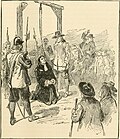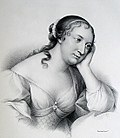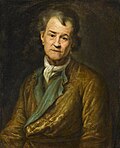Births
1690












- March 3 – Gilbert Livingston (d. 1746)
- January 1
- Christian Falster, Danish writer (d. 1752)
- Susanna Montgomerie, Countess of Eglinton, Scottish literary patron and society hostess (d. 1780)
- January 10 – William Smelt, British Member of Parliament (d. 1755)
- January 13 – Gottfried Heinrich Stölzel, Spanish musician (d. 1749)
- January 14
- Lorenzo Fratellini, Italian painter (d. 1729)
- Chrysostomus Hanthaler, Austrian historian (d. 1754)
- January 16 – Juan Curiel, Spanish intellectual and politician (d. 1775)
- January 17 – Peter Schnitler, Danish/Norwegian jurist and military officer (d. 1757)
- January 19 – William Duncombe, British translator (d. 1769)
- January 22 – Nicolas Lancret, French painter (d. 1743)
- January 24
- Phineas Bowles, British Army officer (d. 1749)
- James Ward, Anglican priest in Ireland (d. 1736)
- January 25 – Jean-Paul de Rome d'Ardène, French botanist, agronomist and priest (d. 1769)
- January 28 – Corbet Kynaston, British Member of Parliament (d. 1740)
- February 1 – Francesco Maria Veracini, Italian composer (d. 1768)
- February 3 – Richard Rawlinson, English minister, antiquarian (d. 1755)
- February 5 – Johann Daniel Schumacher, Russian scholar (d. 1761)
- February 6
- Giovanni Battista Maini, Italian artist (d. 1752)
- Kilian Stobæus, Swedish physician (d. 1742)
- February 7 – Charles Frederick II, Duke of Württemberg-Oels (d. 1761)
- February 9 – Maria Vittoria of Savoy, Italian princess (d. 1766)
- February 11 – Sir William Blackett, 2nd Baronet, British politician (d. 1728)
- February 14 – Jakob Ernst von Liechtenstein-Kastelkorn, Austrian archbishop (d. 1747)
- February 17
- Marcello Papiniano Cusani, Italian archbishop (d. 1766)
- Samuel Phillips, American clergyman (d. 1771)
- February 22 – Daniele Farlati, Italian Jesuit and historian (d. 1773)
- February 26 – Samuel van der Putte, Dutch traveler and explorer (d. 1745)
- February 28 – Alexei Petrovich, Tsarevich of Russia, Russian Tsarevich (d. 1718)
- March 1
- Silvio Valenti Gonzaga, Catholic cardinal (d. 1756)
- Victor Amadeus I, Prince of Carignano, Italian nobleman (d. 1741)
- March 10 – Johann Jakob Schmauss, German jurist (d. 1757)
- March 12 – George Lee, 2nd Earl of Lichfield, British peer (d. 1743)
- March 16 – Benjamin Elbel, German theologian (d. 1756)
- March 18 – Christian Goldbach, Prussian mathematician (d. 1764)
- March 23 – Casimir William of Hesse-Homburg, Prince of Hesse-Homburg (d. 1726)
- March 24 – Sangram Singh II, Maharana of Mewar (d. 1734)
- March 29 – John Montagu, 2nd Duke of Montagu, British duke (d. 1749)
- April 2 – Angelo Piò, Italian sculptor (d. 1769)
- April 8 – Domenico Maria Manni, Italian historian (d. 1788)
- April 9 – Johan Henrik Scheffel, Swedish artist (d. 1781)
- April 13 – Joachim Wagner, organ builder (d. 1749)
- April 14 – Jan Wandelaar, painter and engraver from the Northern Netherlands (d. 1759)
- April 15 – John Wallop, 1st Earl of Portsmouth, English politician and nobleman (d. 1762)
- April 20 – Giuseppe Gonzaga, Duke of Guastalla, Italian noble (d. 1746)
- April 22
- John Carteret, 2nd Earl Granville, British statesman (d. 1763)
- Robert Raikes the Elder, English printer (d. 1757)
- April 25 – Gottlieb Muffat, Austrian composer and organist (d. 1770)
- April 26 – Henri-Joseph Rega, physician and rector of the university of Leuven (d. 1754)
- May 1 – Luke Schaub, British diplomat (d. 1758)
- May 2 – Talbot Yelverton, 1st Earl of Sussex, British Earl (d. 1731)
- May 10 – Jean Moreau de Séchelles, French politician (d. 1761)
- May 14 – Jean Bouillet, French physician (d. 1777)
- May 25 – Joseph Johann Adam, Prince of Liechtenstein (d. 1732)
- May 30 – Anton Sturm, German sculptor (d. 1757)
- June 2 – Louis Petit de Bachaumont, French writer (d. 1771)
- June 3 – François de Pâris, Catholic priest and theologian (d. 1727)
- June 9 – Michel-Étienne Turgot, French lawyer (d. 1751)
- June 11 – Giovanni Antonio Giay, Italian composer (d. 1764)
- June 13 – George Albert, Prince of East Frisia (d. 1734)
- July 7 – Johann Tobias Krebs, German composer and organist (d. 1762)
- July 10 – Sir Henry Oxenden, 4th Baronet, British politician (d. 1720)
- July 12 – Epes Sargent, soldier (d. 1762)
- July 13 – Placidus Böcken, German lawyer (d. 1752)
- July 25 – Ferdinand von Plettenberg, German politician (d. 1737)
- August 3 – Jean Pâris de Monmartel, French private banker (d. 1766)
- September 4 – Polykarp Leyser IV, German academic (d. 1728)
- September 7 – Karl Heinrich von Bogatzky, German hymnwriter (d. 1774)
- September 8
- Zachary Pearce, English bishop (d. 1774)
- Lorenzo Zavateri, Italian baroque violinist (d. 1764)
- September 10 – Maeda Yoshinori, daimyo (d. 1745)
- September 12 – Peter Dens, Belgian Catholic theologian (d. 1775)
- September 15 – Ignazio Prota, Italian composer (d. 1748)
- September 18 – Charles Louis, Duke of Schleswig-Holstein-Sonderburg-Beck (d. 1774)
- September 23 – Giuseppe Bazzani, Italian painter (d. 1769)
- September 28
- Jacques-Barthélemy Micheli du Crest, Genevan cartographer (d. 1766)
- Michel Fourmont, French religious servant and professor (d. 1746)
- James Murray, 2nd Duke of Atholl, British politician (d. 1764)
- October 9 – Robert Woodcock, English artist and composer (d. 1728)
- October 13 – Jean de Boullonges, French politician (d. 1769)
- October 14 – Léopold Philippe d'Arenberg, Austrian field marshal (d. 1754)
- October 15 – Martha Blount, friend of Alexander Pope (d. 1762)
- October 18 – Thomas Lewis, British politician (d. 1777)
- October 19 – Louis-Guillaume Verrier, Canadian lawyer (d. 1758)
- October 28 – Peter Tordenskjold, Norwegian sea officer (d. 1720)
- October 29 – Martin Folkes, English antiquary, numismatist, mathematician, astronomer (d. 1754)
- November 4 – Guillaume-Hyacinthe Bougeant, French Jesuit and writer (d. 1743)
- November 5
- Carlo Giuseppe Merlo, Italian architect of the late-Baroque period (d. 1760)
- Frederick Louis of Württemberg-Winnental, German army commander (d. 1734)
- November 7
- Francisco Carriedo, General of Philippines (d. 1743)
- Dominic Marquard, Prince of Löwenstein-Wertheim-Rochefort, German nobleman (d. 1735)
- November 10 – Christine Charlotte of Solms-Braunfels, Landgravine of Hesse-Homburg (d. 1771)
- November 13 – Ernst Johann von Biron, Duke of Courland and Semigallia (d. 1772)
- November 16 – John Brownlow, 1st Viscount Tyrconnel, Irish Viscount (d. 1754)
- November 17 – Noël-Nicolas Coypel, French painter (d. 1734)
- November 22 – François Colin de Blamont, French composer (d. 1760)
- November 24 (baptized) – Charles Theodore Pachelbel, German/American composer (d. 1750)
- November 28 – Carlo Lodoli, Italian architect (d. 1761)
- November 29 – Christian August, Prince of Anhalt-Zerbst, German general (d. 1747)
- December 1
- Karl Philipp von Greifenclau zu Vollraths, German bishop (d. 1754)
- Philip Yorke, 1st Earl of Hardwicke, English lawyer, politician, Lord Chancellor (d. 1764)
- December 2 – Robert Shafto, British politician (d. 1729)
- December 3 – José Maria da Fonseca e Évora, Franciscan friar and bishop, Portuguese Commissary General of the Franciscan Order (d. 1752)
- December 18 – Sir Edmund Isham, 6th Baronet, English baronet and Member of Parliament (d. 1772)
- December 22
- Marie Anne Éléonore de Bourbon, French noble (d. 1760)
- Meidingu Pamheiba, King of Manipur (d. 1751)
- December 25 – William Dicey (d. 1756)
- date unknown – Thomas Carter, Irish politician (d. 1763)
1691





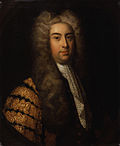



- January 8 – George Charles of Hesse-Kassel, Prince of Hesse-Kassel and Prussian general (d. 1755)
- January 16 – Peter Scheemakers, Flemish sculptor (d. 1781)
- January 18 – William Finch, British diplomat (d. 1766)
- January 19 – Reinier Boitet, Delft publisher and writer (d. 1750)
- January 25 – John Folliot, officer of the British Army (d. 1762)
- January 27 – Christian Ulrich II, Duke of Württemberg-Wilhelminenort (d. 1734)
- February 3 – George Lillo, British writer (d. 1739)
- February 4 – Louis-Basile de Bernage, French jurist (d. 1767)
- February 6 – Francisco Cajigal de la Vega, Spanish general and Viceroy (d. 1777)
- February 8 – John Adams Sr., British colonial farmer, minister, father of the U.S. president, John Adams (d. 1761)
- February 10 – Samuel Wesley, English poet and cleric (d. 1739)
- February 17 – Julius Valentyn Stein van Gollenesse, Governor of Zeylan (d. 1755)
- February 27 – Edward Cave, English editor and publisher (d. 1754)
- March 1 – Conrad Beissel, German-American religious leader (d. 1768)
- March 4 – Pierre-Herman Dosquet, Catholic bishop (d. 1777)
- March 7 – Francesco Alborea, Italian composer and cellist (d. 1739)
- March 12 – Dionisia de Santa María Mitas Talangpaz, Filipino saint (d. 1732)
- March 16 – Michel Baudouin, Canadian missionary (d. 1768)
- March 20 – Princess Dorothea Wilhelmine of Saxe-Zeitz, Landgravine of Hesse-Kassel (d. 1743)
- March 22 – Philipp von Stosch, Prussian antiquarian (d. 1757)
- March 28 – Charles Emil Lewenhaupt, Swedish general (d. 1743)
- March 30 – Charles Hamilton, Count of Arran, English collector of manuscripts (d. 1754)
- March 31 – Franz Hunolt, German preacher (d. 1746)
- April 2 – Christian Ernest of Stolberg-Wernigerode, Count (d. 1771)
- April 5
- Franz Joseph Spiegler, German painter (d. 1757)
- Louis VIII, Landgrave of Hesse-Darmstadt (d. 1768)
- April 6 – Johann Heinrich Zopf, German historian (d. 1774)
- April 8 – John Bampfylde, British politician (d. 1750)
- April 9
- Paul Egell, German sculptor and plasterer (d. 1752)
- Johann Matthias Gesner, German classical scholar and schoolmaster (d. 1761)
- April 13
- Joseph-Charles Roettiers, French engraver and medallist (d. 1779)
- Johann Friedrich Weidler, German astronomer and mathematician (d. 1755)
- April 23 – René Hérault, French police chief (d. 1740)
- April 30 – Henry Ingram, 7th Viscount of Irvine, Scottish peer and politician (d. 1761)
- May 1 – Kasimir Wedig von Bonin, German military personnel (d. 1752)
- May 23 – Giuseppe Orsoni, Italian artist, 1691–1755 (d. 1755)
- May 25 – Infante Francisco, Duke of Beja, Portuguese prince of the second House of Braganza (d. 1742)
- May 27 – James Alexander, American lawyer in colonial New York (d. 1756)
- June 2 – Nicolau Nasoni, Italian architect (d. 1773)
- June 4 – Daniel Horsmanden, American judge (d. 1778)
- June 8 – James Cecil, 5th Earl of Salisbury, English Earl (d. 1728)
- June 14 – Jan Francisci, Slovak organist and composer (d. 1758)
- June 17
- George August, Count of Erbach-Schönberg, German noble (d. 1758)
- Giovanni Paolo Panini, Italian painter and architect (d. 1765)
- June 20 – Pietro Antonio Magatti, Italian painter (d. 1767)
- June 23 – John Thomas, English bishop of Lincoln and bishop of Salisbury (d. 1766)
- July 17 – Peder von Todderud, Danish autobiographer (d. 1772)
- July 24 – Harry Powlett, 4th Duke of Bolton, British politician (d. 1759)
- July 26 – Sir John Trelawny, 4th Baronet, British politician (d. 1756)
- July 31 – Bartolomé Rull, Spanish bishop (d. 1769)
- August 5 – Charles d'Orléans de Rothelin, French priest and scholar (d. 1744)
- August 8 – Christina Beata Dagström, Swedish baroness and glass works owner (d. 1754)
- August 21 – Anne Coventry, Countess of Coventry, English plaintiff in a marriage settlement case (d. 1788)
- August 25 – Alessandro Galilei, Italian architect, mathematician (d. 1737)
- August 28 – Elisabeth Christine of Brunswick-Wolfenbüttel, Holy Roman Empress consort (d. 1750)
- August 29 – Richard Challoner, English Catholic prelate (d. 1781)
- August 30 – Louis-Jean Lévesque de Pouilly, French philosopher (d. 1750)
- September 1 – James Burrough, English academic and architect (d. 1764)
- September 3
- Ana Maria de Lorena, 1st Duchess of Abrantes, Portuguese noblewoman (d. 1761)
- Armande Félice de La Porte Mazarin, French noblewoman, courtier and duelist (d. 1729)
- Antoine-Alexis Perier de Salvert, French naval officer (d. 1757)
- September 20 – Giovanni Francesco Crivelli, Italian mathematician and priest (d. 1743)
- September 22 – Louis-Philippe de Rigaud, Marquis of Vaudreuil, French Navy officer (d. 1763)
- October 1 – Arthur Onslow, Speaker of the British House of Commons (d. 1768)
- October 6 – Sir Edward Turner, 1st Baronet, British Baronet (d. 1735)
- October 11 – John Leland, English Presbyterian minister (d. 1766)
- October 14 – John Lovewell, Nashua, New Hampshire hero (d. 1725)
- October 18 – Kaspar Ernst von Schultze, German military personnel (d. 1757)
- October 20 – Tsarevna Catherine Ivanovna of Russia, Tsarevna of Russia (d. 1733)
- October 27 – Jacob Severin, Dano-Norwegian merchant (d. 1753)
- November 4
- William Bulkeley, sheriff and diarist from Anglesey (d. 1760)
- Dudley Ryder, British politician and judge (d. 1756)
- November 9 – Antonio Francesco Gori, Italian antiquarian (d. 1757)
- November 10 – Wilhelm Heinrich, Duke of Saxe-Eisenach, German duke (d. 1741)
- November 11 – Peregrine Osborne, 3rd Duke of Leeds, British peer (d. 1731)
- November 14
- James Lindsay, 5th Earl of Balcarres, Governor of Jamaica (d. 1768)
- Henry Shirley, 3rd Earl Ferrers, British peer (d. 1745)
- November 18 – Mårten Triewald, merchant and technician, one of the founders of the Royal Swedish Academy of Sciences (d. 1747)
- November 19 – William Fraser, of Fraserfield, politician (d. 1727)
- November 21 – Domingo José Claros Pérez de Guzmán, 13th Duke of Medina Sidonia, noble (d. 1739)
- November 27 – Josef Antonín Plánický, Czech composer, choirmaster and singer (d. 1732)
- December 10 – Cornelis Pronk, Dutch painter (d. 1759)
- December 18 – Gaston-Laurent Coeurdoux, French Indianist and missionary (d. 1779)
- December 30 – Conrad Friedrich Hurlebusch, German Dutch composer and organist (d. 1765)
1692











- January 6 – Francesco Maria Zanotti, Italian philosopher (d. 1777)
- January 7 – Petrus Wesseling, German librarian, law librarian and writer (d. 1764)
- January 12 – Ferdinand Maximilian II of Isenburg-Wächtersbach, count of Isenburg-Wächtersbach (d. 1755)
- January 13 – Gunnila Grubb, Swedish spiritual poet (d. 1729)
- January 24 – Paweł Giżycki, Polish painter and architect (d. 1762)
- January 27 – Ivan Cherkasov, Russian statesman, privy councillor, and cabinet secretary (d. 1758)
- January 30 – William Granville, 3rd Earl of Bath, English peer (d. 1711)
- January 31 – John Conybeare, British bishop (d. 1755)
- February 13 – Louis, Prince of Lambesc, French prince (d. 1743)
- February 14 – Pierre-Claude Nivelle de La Chaussée, French playwright (d. 1754)
- February 16 – Giovanni Domenico Mansi, Roman Catholic archbishop (d. 1769)
- February 17 – Christian David, German religious servant, missionary and carpenter (d. 1751)
- February 18 – Johann Michael Fischer, German architect (d. 1766)
- February 25
- John Hawkins, Master of Pembroke College, Cambridge (d. 1733)
- Karl Ludwig von Pöllnitz, German soldier, adventurer and writer (d. 1775)
- February 29 – John Byrom, poet, inventor of a shorthand system (d. 1763)
- March 5 – Sir John Shelley, 4th Baronet, English politician (d. 1771)
- March 14 – Pieter van Musschenbroek, Dutch naturalist (d. 1761)
- March 25 – Tokugawa Tsugutomo, daimyo (d. 1731)
- March 26 – Jean II Restout, French painter (d. 1768)
- April 1 – William, Landgrave of Hesse-Philippsthal-Barchfeld (d. 1761)
- April 4
- James Carnegie, 5th Earl of Southesk, Scottish earl (d. 1730)
- André Souste, Royal Notary in Canada (d. 1776)
- April 5
- Jean Calmette, French jesuit and indologist (d. 1740)
- Adrienne Lecouvreur, French actress (d. 1730) [134]
- April 7 – Pietro Marchesini, Italian painter (d. 1757)
- April 8 – Giuseppe Tartini, Italian composer and violinist (d. 1770)
- April 22 – James Stirling, Scottish mathematician (d. 1770)
- April 29 – Jean Armand de Lestocq, French adventurer (d. 1767)
- May 3 – Jan Jacob Mauricius, Dutch diplomat (d. 1768)
- May 9 – Giuseppe Agostino Orsi, Catholic cardinal (d. 1761)
- May 10 – John Brailsford the elder, English poet (d. 1739)
- May 11 – Sir Thomas Sebright, 4th Baronet, English politician, 1692–1736 (d. 1736)
- May 16 – Dolly Pentreath, last known native speaker of the Cornish language prior to its revival in 1904 (d. 1777)
- May 17 – Edward Lisle, British Member of Parliament (d. 1753)
- May 18 – (O.S) Joseph Butler, English bishop and philosopher (d. 1752) [135]
- May 25 – Archibald Douglas, 2nd Earl of Forfar, Scottish earl (d. 1715)
- May 28
- Geminiano Giacomelli, Italian composer (d. 1740)
- Karl von Haimhausen, German missionary (d. 1767)
- June 13 – Joseph Highmore, British artist (d. 1780)
- June 15
- Giovanni Domenico Ferretti, Italian painter (d. 1768)
- Ōkubo Tadamasa, daimyo (d. 1732)
- June 28 – Louisa Maria Stuart, British princess (d. 1712)
- June 29 – Jean-François Du Bellay du Resnel, French Roman Catholic priest (d. 1761)
- July 1 – Antonio Sandini, Italian ecclesiastical historian (d. 1751)
- July 7 – Edward Montagu, Viscount Hinchingbrooke, British politician and noble (d. 1722)
- July 16 – Antoine Thiout, clockmaker (d. 1767)
- July 19 – Frederick William, Duke of Courland (d. 1711)
- July 24 – Sir James Dalrymple, 2nd Baronet, British politician (d. 1751)
- August 3 – John Henley, English clergyman (d. 1756)
- August 6 – Peter Burrell, politician (d. 1756)
- August 8 – Juan Manuel de la Puente, Spanish composer (d. 1753)
- August 14 – Frederick Anton, Prince of Schwarzburg-Rudolstadt (d. 1744)
- August 18
- Jacob Folkema, Dutch engraver (d. 1767)
- Louis Henri, Duke of Bourbon, French politician and prince (d. 1740)
- August 27 – Jacob Christiaan Pielat, Dutch colonial governor (d. 1740)
- August 29 – Nicolas Grozelier, French writer (d. 1778)
- September 1 – Egid Quirin Asam, German sculptor (d. 1750)
- September 11 – Ingela Gathenhielm, Swedish privateer (d. 1729)
- September 12 – Christine Eleonore of Stolberg-Gedern (d. 1745)
- September 15 – Anselm Franz von Ritter zu Groenesteyn, German architect (d. 1765)
- September 16 – Johanna Elisabeth Döbricht, German soprano (d. 1786)
- September 25 – Franz Albert Schultz, German academic (d. 1763)
- September 26
- Ernst von Steinberg, Hanoverian minister and head of the German Chancery in London (d. 1759)
- Pietro Antonio Trezzini, Russian architect (d. 1760)
- September 27 – Georg Heinrich Zincke, German academic (d. 1769)
- October 3 – Pierre Grimod du Fort, French art collector (d. 1748)
- October 4 – Francis Willoughby, 2nd Baron Middleton, British politician (d. 1758)
- October 6 – Johann Heinrich Pott, German chemist (d. 1777)
- October 8 – Antonio Palella, Italian composer (d. 1761)
- October 15 – Alessandro Albani, collector of antiquities, Roman Catholic cardinal (d. 1779)
- October 18 – Magnus Beronius, Swedish archbishop (d. 1775)
- October 19 – Jehu Curtis, American judge (d. 1753)
- October 24 – Albert Brahms, German pioneer hydraulic engineer (d. 1758)
- October 25 – Elisabeth Farnese, queen of Philip V of Spain (d. 1766)
- October 28 – Joseph Ferdinand of Bavaria, Electoral Prince of Bavaria (d. 1699)
- October 30 – Unico Wilhelm van Wassenaer, Dutch noble, diplomat and composer (d. 1766)
- October 31 – Anne Claude de Caylus, French antiquarian (d. 1765)
- November 6 – Louis Racine, French poet of the Age of the Enlightenment (d. 1763)
- November 7
- Johann Gottfried Schnabel, German writer (d. 1750)
- Giuseppe Zinanni, Italian scientist (d. 1753)
- November 8 – Laurentius Blumentrost, Russian court physician and founder and first president of St. Petersburg Academy of Sciences (d. 1755)
- November 11
- Muhammad Hashim Thattvi, Islamic scholar, author, philanthropist, and spiritual leader (d. 1761)
- Louis Guy Henri de Valori, French diplomat (d. 1774)
- November 15 – Eusebius Amort, German Roman Catholic theologian (d. 1775)
- November 17 – John Betts Jr., Connecticut politician (d. 1767)
- November 21 – Carlo Innocenzo Frugoni, Italian poet (d. 1768)
- November 28
- Willoughby Bertie, 3rd Earl of Abingdon (d. 1760)
- Esprit Pezenas, French astronomer (d. 1776)
- November 30 – Livio Retti, Italian artist (d. 1751)
- December 1 – Isaac Kimber, English journalist and minister (d. 1755)
- December 4 – Ferdinand Leopold, Count of Hohenzollern-Sigmaringen, German nobleman; ruling Count of Hohenzollern-Haigerloch (d. 1750)
- (baptised) December 27 – Francis Blake Delaval, British Royal Navy officer and Member of Parliament (d. 1752)
- December 28 – Robert Shirley, Viscount Tamworth, English politician (d. 1714)
- December 29
- Thomas Angell, Norwegian merchant/estate/mine owner/philanthropist (d. 1767)
- Franz Georg Hermann, German painter (d. 1768)
- December 30 – Marie Christine Felizitas of Leiningen-Dagsburg-Falkenburg-Heidesheim (d. 1734)
1693












- January 1 – Francesco Carlo Rusca, Swiss painter (d. 1769)
- January 3
- Giovanni Bianchi, Italian physician and zoologist (d. 1775)
- Matthew Hutton, Archbishop of York and Archbishop of Canterbury (d. 1758)
- January 12 – Queen Jeongseong, Queen Consort of Korea (d. 1757)
- January 16 – Francesco Campora, Italian painter (d. 1763)
- January 17 – Melchor de Navarrete, Spanish colonial governor of Florida and Mexico (d. 1761)
- January 19
- Jonathan Rashleigh, politician (d. 1764)
- Hyacinthe Collin de Vermont, French painter (d. 1761)
- January 23 – Georg Bernhard Bilfinger, German mathematician (d. 1750)
- January 26 – William Robinson, deputy governor of the Colony of Rhode Island and Providence Plantations (d. 1751)
- January 28
- Robert Sawyer Herbert, British Member of Parliament (d. 1769)
- Empress Anna of Russia, Empress of Russia (d. 1740)
- Gregor Werner, Austrian composer (d. 1766)
- January 29 – Henry Herbert, 9th Earl of Pembroke, English peer and architect (d. 1750)
- January 30 – Countess Palatine Maria Anna of Neuburg, Countess Palatine of Neuburg by birth, Duchess of Bavaria (d. 1751)
- February 12 – Avdotya Chernysheva, Russian lady-in-waiting (d. 1747)
- February 13 – José del Campillo, Spanish politician (d. 1743)
- February 15 – Peter Schenk the Younger, German engraver and map publisher (d. 1775)
- February 24
- James Quin, English actor (d. 1766)
- Johann Jacob Rambach, German theologian (d. 1735)
- March 2 – Sir Thomas Wheate, 2nd Baronet, English politician (d. 1746)
- March 5 – Johann Jakob Wettstein, Swiss theologian (d. 1754)
- March 6 – Edward Willes, English Anglican bishop and cryptanalyst (d. 1773)
- March 7 – Pope Clement XIII, pope of the Catholic Church (d. 1769) [136]
- March 15 – Sir William Heathcote, 1st Baronet, British politician (d. 1751)
- March 16 – Malhar Rao Holkar, Indian nobleman (d. 1766)
- March 17 – Countess Palatine Elisabeth Auguste Sofie of Neuburg, Grandmother of Maximilian I Joseph of Bavaria (d. 1728)
- April 1 – Melusina von der Schulenburg, Countess of Walsingham, British Countess (d. 1778)
- April 3
- George Edwards, English naturalist (d. 1773)
- John Harrison, English clockmaker, horologist and inventor of the marine chronometer (d. 1776)
- April 4 – John West, 1st Earl De La Warr, British general (d. 1766)
- April 13 – Johann Georg Keyßler, German polymath (d. 1743)
- April 16
- Mary Alexander, British American merchant (d. 1760)
- Anne Sophie Reventlow, Danish royal consort, Queen of Denmark-Norway (d. 1743)
- April 20 – Daniel Brodhead II, American justice of the peace (d. 1755)
- April 25 – Sir Charles Hotham, 5th Baronet, British diplomat (d. 1738)
- April 26 – William Wollaston, British politician (d. 1757)
- April 29 – Asmus Ehrenreich von Bredow (d. 1756)
- April 30 – Giuseppe Maria Feroni, Italian cardinal (d. 1767)
- May 4 – Thomas Gent, Irish printer and writer (d. 1778)
- May 9 – Charles Howard, 7th Earl of Suffolk, English Earl (d. 1722)
- May 10
- John Fox, English biographer (d. 1763)
- Henry Hare, 3rd Baron Coleraine, Irish peer and politician (d. 1749)
- May 15 – Henry Winder, English chronologist (d. 1752)
- May 24 – Georg Rafael Donner, Austrian sculptor (d. 1741)
- May 31 – Bartolomeo Nazari, Italian painter (d. 1758)
- June 1
- Alexey Bestuzhev-Ryumin, Russian diplomat, chancellor of the Russian Empire (d. 1768)
- Johann Dietrich von Hülsen, German canon (d. 1767)
- June 17
- Prince Charles William of Hesse-Darmstadt, Prince of Hesse-Darmstadt and Obrist (d. 1707)
- Diego de Torres Villarroel, Spanish writer (d. 1770)
- Johann Georg Walch, German theologian (d. 1775)
- June 19 – Christian August Hausen, German mathematician and physicist (d. 1743)
- June 20 – Wilhelmina Maria Frederica of Rochlitz, Polish noble (d. 1729)
- June 29 – Juan Bautista de Anza I, Spanish militar and explorer (d. 1740)
- July 7 – Gilles-François de Beauvais, French Jesuit (d. 1773)
- July 12 – Jean-Baptiste de Brancas, Roman Catholic archbishop (d. 1770)
- July 16 – Cecilia Rosa de Jesús Talangpaz, Servant of God (d. 1731)
- July 17 – Gerard Melder, miniature and watercolor painter from the Northern Netherlands (d. 1754)
- July 21 – Thomas Pelham-Holles, 1st Duke of Newcastle, Prime Minister of Great Britain (d. 1768) [137]
- July 26 – Alexandre Le Riche de La Poupelinière, Patron of music and literature (d. 1762)
- August 1 – Hugh Hughes, Welsh poet (d. 1776)
- August 7
- Sir Edmund Bacon, 5th Baronet, British politician (d. 1738)
- Charles, Prince of Rochefort, French noble (d. 1763)
- August 8 – Laurent Belissen, French composer (d. 1762)
- August 9
- Anne Cecil, Countess of Salisbury, British noble (d. 1757)
- Princess Sophia Wilhelmina of Saxe-Coburg-Saalfeld, Princess of Saxe-Coburg-Saalfeld by birth and by marriage Princess of Schwarzburg-Rudolstadt (d. 1727)
- August 11 – Francisco de Merlo, Spanish noblemen, military and notary (d. 1758)
- August 13 – Gustavus Handcock, Irish politician (d. 1751)
- September 3 – Charles Radclyffe, Titular 5th Earl of Derwentwater (d. 1746)
- September 7 – Victor I, Prince of Anhalt-Bernburg-Schaumburg-Hoym (d. 1772)
- September 9 – Quinault-Dufresne, French actor (d. 1767)
- September 10 – James MacSparran, Church of England clergyman in America (d. 1757)
- September 13 – Joseph Emanuel Fischer von Erlach, Austrian architect (d. 1742)
- September 19 – Louis Charles Armand Fouquet, French general and diplomat (d. 1747)
- September 21 – Thomas Secker, Archbishop of Canterbury (d. 1768)
- September 22 – Simon Nikolaus Euseb von Montjoye-Hirsingen, Prince Bishop of Basel (d. 1775)
- October 3 – Conway Blennerhassett, Irish politician (d. 1724)
- October 5 – Johann Christian Buxbaum, German physician, botanist and traveller (d. 1730)
- October 6 – Marie-Madeleine de Parabère, French aristocrat (d. 1755)
- October 9 – Johann Lorenz von Mosheim, German church historian (d. 1755)
- October 11
- Frederick Charles, Prince of Stolberg-Gedern (d. 1767)
- John Hobart, 1st Earl of Buckinghamshire, British politician (d. 1756)
- October 14 – Daniel Maichel, German philosopher (d. 1752)
- October 15 – Sir Edward Wilmot, 1st Baronet, Royal surgeon (d. 1786)
- October 18
- John Chandler, American judge and sheriff (d. 1762)
- John Gilbert, Archbishop of York (d. 1761)
- Jeremiah Markland, British classical scholar (d. 1776)
- October 20 – Gideon Wanton, Rhode Island colonial governor (d. 1767)
- October 21
- Adriaan van der Burg, painter from the Northern Netherlands (d. 1733)
- Frederik Nannestad, Norwegian bishop (d. 1774)
- October 22 – Thomas Fairfax, 6th Lord Fairfax of Cameron, American planter (d. 1781)
- October 25 – Antoine Ferrein, French anatomist (d. 1769)
- October 28 – Šimon Brixi, Czech composer (d. 1735)
- October 30 – Samuel Chew, American judge (d. 1743)
- November 5 – Ivan Neplyuyev, Russian noble (d. 1773)
- November 9 – Countess Henriette Charlotte of Nassau-Idstein, German princess (d. 1734)
- November 10 – Roland-Michel Barrin de La Galissonière, French admiral (d. 1756)
- November 13 – Thomas Watson-Wentworth, 1st Marquess of Rockingham, British politician (d. 1750)
- November 22
- Louise Élisabeth de Bourbon, daughter of Louis (d. 1775)
- Zheng Xie, Chinese painter (d. 1766)
- November 28 – Anthonie van der Heim, Dutch politician, urban magistrate and judge in Rotterdam, Grand Pensionary of Holland (d. 1746)
- November 30 – Christoph Förster, German composer (d. 1745)
- December 9 – Nathaniel Appleton, Congregational minister (d. 1784)
- December 29 – Pierre Joseph Céloron de Blainville, French explorer (d. 1759)
- date unknown – Heyat Mahmud, Bengali poet (d. 1760)
1694











- January 1 – Abdallah of Morocco, Sultan of Morocco (d. 1757)
- January 3 – Paul of the Cross, Italian mystic (d. 1775)
- January 5 – Theophilus Siegfried Bayer, German sinologst (d. 1738)
- January 6 – Melchor Chyliński, Polish presbyter (d. 1741)
- January 12
- Oluf Blach, Danish merchant (d. 1767)
- Johann Heinrich Callenberg, German theologian (d. 1760)
- January 25 – Simon Henry Adolph, Count of Lippe-Detmold (d. 1734)
- January 28 – Peter Collinson, botanist (d. 1768)
- February 1 – Giuseppe Spinelli, Catholic cardinal (d. 1763)
- February 4 – Georg Gottlob Richter, German philosopher and physician (d. 1773)
- February 11 – Henrietta Harley, Countess of Oxford and Countess Mortimer, English noblewoman (d. 1755)
- February 18 – Johann Christoph Handke, Czech painter (d. 1774)
- February 21 – Richard Waldron, Colonial New Hampshire businessman and politician (d. 1753)
- February 24 – Bartolomeo Altomonte, Austrian artist (d. 1783)
- March 11 – Elizabeth Tollet, British poet (d. 1754)
- March 15 – Friedrich Michael Ziegenhagen, English clergyman with German connection (d. 1776)
- March 21 – Daniel Scott, British lexicographer (d. 1759)
- March 24
- Giuseppe Bernardi, Italian sculptor (d. 1774)
- Thomas Bullock, Anglican dean (d. 1760)
- March 25 – Christian Otto of Limburg, Reigning count of Limburg-Styrum-Styrum (d. 1749)
- April 3 – George Edwards, English naturalist and ornithologist (d. 1773)
- April 14 – Maximilien-Henri de Horion (d. 1759)
- April 25 – Richard Boyle, 3rd Earl of Burlington, English architect (d. 1753)
- April 30 – William Pitkin, Governor of the Connecticut Colony (d. 1769)
- May 7 – Pierre-Jean Mariette, French art historian (d. 1774)
- May 8 – Étienne Lauréault de Foncemagne, French writer (d. 1779)
- May 10 – Michael Harvey, British Member of Parliament (d. 1748)
- May 11
- Princess Maria Theresia of Liechtenstein, Czech noblewoman (d. 1772)
- Hieronymus Florentinus Quehl, German composer (d. 1739)
- May 22 – Daniel Gran, Austrian painter (d. 1757)
- June 3 – Scawen Kenrick, English clergyman (d. 1753)
- June 4 – François Quesnay, French economist (d. 1774)
- June 6 – Francis Wollaston, English scientist (d. 1774)
- June 9 – Price Devereux, 10th Viscount Hereford, British politician (d. 1748)
- June 11 – Thomas Willoughby, British politician (d. 1742)
- June 18 – Karl Heinrich von Hoym, German diplomat, statesman and politician (d. 1736)
- June 19 – Jean-André Peyssonnel, French physician (d. 1759)
- June 20 – Hans Adolph Brorson, Danish bishop (d. 1764)
- June 23 – Stamp Brooksbank, MP and Governor of the Bank of England (d. 1756)
- June 24 – Jean-Jacques Burlamaqui, Genevan legal and political theorist (d. 1748)
- June 26 – Georg Brandt, Swedish chemist and mineralogist (d. 1768)
- June 27 – John Michael Rysbrack, Flemish sculptor (d. 1770)
- June 29 – Maria Josepha of Dietrichstein, German noblewoman, member of the House of Dietrichstein; by marriage Countess and later Princess Kinsky of Wchinitz und Tettau (d. 1758)
- July 4
- Claudio Francesco Beaumont, Italian painter (d. 1766)
- Louis-Claude Daquin, French composer (d. 1772)
- July 11 – Charles-Antoine Coypel, French painter, art commentator, and playwright (d. 1752)
- July 12 – Duchess Gustave Caroline of Mecklenburg-Strelitz, German noble (d. 1748)
- July 16 – Marcus Beresford, 1st Earl of Tyrone, Irish politician (d. 1763)
- July 18
- Alexander Buturlin, Russian general and courtier (d. 1767)
- Margarete von Leiningen-Westerburg-Neuleiningen (d. 1761)
- August 1 – Michael Davies, priest (d. 1779)
- August 3 – Marc-Antoine-Nicolas de Croismare, French dilettante (d. 1772)
- August 4 – Étienne-François Avisse, French playwright (d. 1747)
- August 5 – Leonardo Leo, Italian composer (d. 1744)
- August 8 – Francis Hutcheson, Scottish philosopher (d. 1746)
- August 10 – John Leveson-Gower, 1st Earl Gower, British politician (d. 1754)
- August 11 – Giorgio Baffo, Venetian senator and poet (d. 1768)
- August 14
- James Hamilton, 1st Earl of Clanbrassil, Member of the Parliament of Great Britain (d. 1758)
- Henry Howard, 4th Earl of Carlisle, English noble and politician (d. 1758)
- August 16 – Réginald Outhier, French astronomer and priest (d. 1774)
- August 19 – Elizabeth Compton, Countess of Northampton, British noble (d. 1741)
- August 20
- Stephanus Versluys, Dutch colonial governor (d. 1736)
- Christiane Charlotte of Württemberg-Winnental, German noble (d. 1729)
- August 23 – Johann Georg Schmidt, engraver from Germany (d. 1767)
- August 25
- Theodore of Corsica, German noble (d. 1756)
- Hongxi, prince (d. 1742)
- August 26 – Elisha Williams, American rector of Yale College (d. 1755)
- August 27 – Henry Osborn, Royal Navy admiral (d. 1771)
- August 28 – Charlotte Christine of Brunswick-Wolfenbüttel, Grand Duchess of Russia (d. 1715)
- September 6 – Johann Daniel Schöpflin, German historian (d. 1771)
- September 7 – Johan Ludvig Holstein, Danish politician (d. 1763)
- September 9 – John Vanderbank, British artist (d. 1739)
- September 12 – Johan von Mangelsen, Norwegian businessman and general (d. 1769)
- September 13 – Yeongjo of Joseon, 21st King of Joseon Dynasty in Korean history (d. 1776)
- September 18 – Jacques-Ignace de La Touche, painter (d. 1781)
- September 22 – Philip Stanhope, 4th Earl of Chesterfield, British statesman and man of letters (d. 1773)
- September 25 – Henry Pelham, Prime Minister of the United Kingdom (d. 1754)
- September 26 – Martin Schmid, Swiss composer and architect (d. 1772)
- October 4
- George Murray, Scottish Jacobite general (d. 1760)
- Tsarevna Praskovya Ivanovna of Russia, daughter of Tsar Ivan V of Russia (d. 1731)
- October 9 – Marquard Herrgott, German Benedictine historian and diplomat (d. 1762)
- October 14 – Jacob Bouverie, 1st Viscount Folkestone, British politician (d. 1761)
- October 15
- Archibald Douglas, 1st Duke of Douglas, Scottish nobleman (d. 1761)
- William Knollys, English politician from Oxfordshire (d. 1740)
- October 18 – René Louis de Voyer de Paulmy d'Argenson, French statesman (d. 1757)
- October 24 – Humphrey Sydenham, British politician (d. 1757)
- October 26
- Sir George Oxenden, 5th Baronet, English politician (d. 1775)
- Johan Helmich Roman, Swedish Baroque composer (d. 1758)
- October 27 – Simon Pelloutier, German historian (d. 1757)
- November 2 – Count Palatine Joseph Charles of Sulzbach, Heir apparent of Neuburg, Sulzbach and the Palatinate (d. 1729)
- November 3
- John May, English shipwright (d. 1779)
- William Mackworth Praed, British politician (d. 1752)
- November 5 – Ricardo Wall, Irish-born soldier, diplomat and minister in the Spanish service (d. 1777)
- November 12 – Augustine Washington, British-American planter, slave owner, and the father of George Washington (d. 1743)
- November 16 – Isabella Simons, banker in the Austrian Netherlands (d. 1756)
- November 21 – Voltaire, French writer, historian, and philosopher (d. 1778) [138]
- November 23 – Charlotte Daneau de Muy, Canadian historian (d. 1759)
- November 26 – Louis de Boissy, French writer (d. 1758)
- November 29 – Leopold, Prince of Anhalt-Köthen, German prince and ruler of the principality of Anhalt-Köthen (d. 1728)
- December 2 – William Shirley, British governor of Massachusetts and then of the Bahamas (d. 1771)
- December 10 – Vittorio Francesco, Marquis of Susa, Prince of Savoy (d. 1762)
- December 11 – Johann Michael von Loën, German author (d. 1776)
- December 20 – Andrew Johnston, American politician (d. 1762)
- December 22 – Hermann Samuel Reimarus, German philosopher and writer (d. 1768)
- December 24
- Louisa Berkeley, Countess of Berkeley, British noble (d. 1716)
- Christfried Kirch, German astronomer (d. 1740)
1695













- January 2 – Sir Robert Cotton, 3rd Baronet, British politician (d. 1748)
- January 6 – Giuseppe Sammartini, Italian composer and oboist (d. 1750)
- January 9 – Ferdinand Ashmall, British clergy (d. 1798)
- January 18 – Paul Bécart de Granville et de Fonville, French colonial officer (d. 1754)
- January 25
- Prince Francis Ernest of Hesse-Darmstadt, German aristocrat (d. 1716)
- Satake Yoshitada (d. 1715)
- January 26 – José Quer y Martínez, Spanish botanist (d. 1764)
- January 27 – Anne Howard, Countess of Effingham, British countess (d. 1774)
- February 2
- William Borlase, English antiquarian, geologist and naturalist (d. 1772)
- François de Chevert, French general (d. 1769)
- Christoph Sauer, German-American printer and publisher (d. 1757)
- February 6 – Nicolaus II Bernoulli, Russian mathematician (d. 1726)
- February 10 – Armand Jules de Rohan-Guéméné, French archbishop (d. 1762)
- February 11
- Françoise de Graffigny, French writer (d. 1758)
- Abraham Pelt, Danish industrialist and philanthropist (d. 1783)
- February 13 – Francesco Maria Della Rovere, politician (d. 1768)
- February 14 – Joseph Anton Glantschnigg, painter of German origin (d. 1755)
- February 16 – Philippe-Claude de Montboissier de Beaufort, French politician (d. 1765)
- February 21 – Anthony Grey, Earl of Harold, English noble (d. 1723)
- March 2 – Bernhard Christoph Breitkopf, German music publisher (d. 1777)
- March 3 – María Anna Águeda de San Ignacio, Mexican writer (d. 1756)
- March 4 – Marie Huber, Genevan writer and theologian (d. 1753)
- March 9 – Martín Sarmiento, Spanish scholar and writer (d. 1772)
- March 10 – Adrien Manglard, French painter and engraver (d. 1760)
- March 12 – Mihael Summa, Albanian clergyman and auxiliary bishop (d. 1777)
- March 13 – Daniel Overbeek, Dutch colonial governor (d. 1751)
- March 15
- Infante António of Portugal, Portuguese infante (d. 1757)
- Alexander Joseph Sulkowski, Polish and Saxon general (d. 1762)
- March 16
- Christian Hilfgott Brand, German Austrian painter (d. 1756)
- William Greene, Governor of the Colony of Rhode Island and Providence Plantations (d. 1758)
- March 19
- William Noel, English barrister, judge and politician, (d. 1762)
- Christian Seybold, German painter (d. 1768)
- March 20 – Toki Yoritoshi, Daimyo in the Tokugawa shogunate (d. 1744)
- March 27 – Johann Philipp Anton von Franckenstein, German priest (d. 1753)
- April 8 – Johann Christian Günther, German poet (d. 1723)
- April 14 – Pietro Guarneri, Italian luthier (d. 1762)
- April 16 – Christoph Jacob Trew, German physician and botanist (d. 1769)
- April 17 – Ludovico Valenti, Italian cardinal (d. 1763)
- April 19
- Roger Morris, English architect (d. 1749)
- Georg Albrecht of Saxe-Weissenfels, Count of Barby, German noble, Count of Barby (d. 1739)
- May 1 – Pierre Saint-Sevin, French composer (d. 1768)
- May 2 – Giovanni Niccolò Servandoni, French architect and painter (d. 1766)
- May 3
- Pacifico Bizza, Roman Catholic archbishop (d. 1756)
- Henri Pitot, French hydraulic engineer (d. 1771)
- May 6 – Isaac Wilkinson, English businessman (d. 1784)
- May 7
- Sir Robert Grosvenor, 6th Baronet, British politician (d. 1755)
- Gabriel Huquier, French art dealer (d. 1772)
- May 8 – John Lee, British politician (d. 1761)
- May 16 – Louis-Urbain-Aubert de Tourny, French intendant (d. 1760)
- May 22 – Anna Folkema, Engraver from the Northern Netherlands (d. 1768)
- May 27 – Miguel Cabrera, Mexican painter (d. 1768)
- May 28 – Alexander Leslie, 5th Earl of Leven, British politician (d. 1754)
- June 3 – Francis Wise, Keeper of the archive at the University of Oxford (d. 1767)
- June 5 – Johann Conrad Schlaun, German architect (d. 1773)
- June 6 – Adriaan Valckenier, Dutch Governor-General of the Dutch East Indies (1737-1741) (d. 1751)
- June 14 – Johann Friedrich Walther, German teacher, organist and draughtsman (d. 1776)
- June 17 – Henri-Michel Guedier de Saint-Aubin, French theologist (d. 1741)
- June 21
- Joseph Banks, English landowner and MP (d. 1741)
- Sir Peter Halkett, 2nd Baronet, politician (d. 1755)
- June 23 – Louise Anne de Bourbon, French princess, the daughter of Louis III de Bourbon (d. 1758)
- June 24 – Martin van Meytens, Austrian artist (d. 1770)
- June 28 – Christiana Mariana von Ziegler, German poet (d. 1760)
- July 2
- Sir Orlando Bridgeman, 4th Baronet, British politician 1695–1764 (d. 1764)
- Louis Charles César Le Tellier, French military commander and Marshal of France (d. 1771)
- July 6 – Giovanni Francesco II Brignole Sale, Italian politician (d. 1760)
- July 17
- Alexandre de Gusmão, Portuguese diplomat (d. 1753)
- Christian Karl Reinhard of Leiningen-Dagsburg-Falkenburg, Count of Leiningen-Dagsburg (d. 1766)
- Alexander Moncrieff, Scottish minister of the Secession church (d. 1761)
- July 18 – Boris Grigoryevich Yusupov, Russian politician (d. 1759)
- July 21 – Thomas Archer, 1st Baron Archer, British politician (d. 1768)
- July 28 – Yunlu, prince Zhuang of the First Rank (d. 1767)
- July 30 – Charles Philippe d'Albert de Luynes, French noble (d. 1758)
- August 1 – John Rutherford, Scottish physician (d. 1779)
- August 3 – Antonio Cocchi, Italian physician and naturalist (d. 1758)
- August 9 – Andreas Murray, Swedish priest (d. 1771)
- August 10 – Samuel Sandys, 1st Baron Sandys, British politician (d. 1770)
- August 11 – Michelangelo Unterberger, Austrian painter (d. 1758)
- August 14 – Mikołaj Krzysztof Radziwiłł, Lithuanian–Polish noble (d. 1715)
- August 17 – Gustaf Lundberg, Swedish rococo painter (d. 1786)
- August 20 – Marie Louise Élisabeth d'Orléans, French princess (d. 1719)
- August 26 – Marie-Anne-Catherine Quinault, French opera singer and composer (d. 1791)
- August 31 – Maximilian, Prince of Hornes, prince (d. 1763)
- September 3 – Pietro Locatelli, Italian Baroque composer and violinist (d. 1764)
- September 5 – Carl Gustaf Tessin, Swedish count, politician and art collector (d. 1770)
- September 6 – Charles Pole, British businessman and politician (d. 1779)
- September 7 – François Hus, French comedian (d. 1774)
- September 10 – Johann Lorenz Bach, German composer (d. 1773)
- September 15 – Michel Lullin de Chateauvieux, Genevan agronomist (d. 1781)
- September 21 – Ferdinando Colonna of Stigliano, 2nd Prince of Sonnino (d. 1775)
- September 22 – Mathias Chardon, French historian (d. 1771)
- September 27 – Anders Anton von Stiernman, Swedish historian (d. 1765)
- October 5 – John Glas, Scottish theologian (d. 1773)
- October 23 – François de Cuvilliés, Bavarian architect (d. 1768)
- October 31 – Nicolas-Joseph de Noyelles de Fleurimont, French soldier (d. 1761)
- November 1 – Pablo Maroni, Austrian missionary (d. 1757)
- November 4
- John Erskine of Carnock, Scottish legal scholar (d. 1768)
- Fabrizio Serbelloni, Catholic cardinal (d. 1775)
- November 9 – Theodosia Bligh, 10th Baroness Clifton, English peer, born Theodosia Hyde (d. 1722)
- November 10 – John Bevis, English physician and astronomer (d. 1771)
- November 17 – Barthold Douma van Burmania, Dutch diplomat (d. 1766)
- December 1 – Francesco Saverio Quadrio, Italian scholar (d. 1756)
- December 2 – Andrzej Stanisław Załuski, Polish bishop (d. 1758)
- December 11 – Charles Guillaume Loys de Bochat, jurist (d. 1754)
- December 12 – Michael Christoph Hanow, German historian and scientist (d. 1773)
- December 15 – Benigna Marie of Reuss-Ebersdorf, German noblewoman and author of hymns (d. 1751)
- December 18 – David Nitschmann der Bischof, bishop (d. 1772)
- December 19
- Andrea Locatelli, Italian painter (d. 1741)
- Joseph Gascoigne Nightingale, British Member of Parliament (d. 1752)
- Jacob de Wit, Dutch painter (d. 1754)
- December 22 – Rebecca Kellogg Ashley, captive of Native Americans (d. 1757)
- December 26 – Johann Caspar Bachofen, Swiss composer (d. 1755)
- December 29 – Jean-Baptiste Pater, French painter (d. 1736)
- date unknown – Hedvig Catharina De la Gardie, Swedish salonnière (d. 1745)
1696













- January 5 – Giuseppe Galli Bibiena, Italian artist (d. 1757)
- January 8 – Étienne Parrocel, French painter (d. 1775)
- January 11 – Frederick William, Prince of Solms-Braunfels (d. 1761)
- January 14
- Troiano Acquaviva d'Aragona, Italian cardinal (d. 1747)
- John Hippisley, English actor and theatre manager (1696–1748) (d. 1748)
- January 17
- Jean de Beaurain, French geographer (d. 1771)
- Laurent Delvaux, Flemish sculptor (d. 1778)
- Ambrose Madison, American planter and politician (d. 1732)
- January 18
- Ludovico Calini, Italian cardinal (d. 1782)
- Sebastian Klotz, German violin maker (d. 1775)
- January 22 – Johann Jakob Brucker, German historian of philosophy (d. 1770)
- January 31 – John Wigan, British physician and author (1696–1739) (d. 1739)
- February 2 – Juan José Eguiara y Eguren, Mexican bishop (d. 1763)
- February 3 – Caspar Wistar, American glassmaker (d. 1752)
- February 4 – Marco Foscarini, 117th Doge of Venice (d. 1763)
- February 10 – Johann Melchior Molter, German composer (d. 1765)
- February 17 – Ernst Gottlieb Baron, German composer (d. 1760)
- February 22 – Henrietta Polyxena of Vasaborg, Swedish countess (d. 1777)
- February 25 – Jean-Philippe-René de La Bléterie, French historian and translator (d. 1772)
- February 29 – Esprit Antoine Blanchard, French baroque composer (d. 1770)
- March 5 – Giovanni Battista Tiepolo, Italian painter (d. 1770)
- March 6 – Joseph Anton Feuchtmayer, German sculptor (d. 1770)
- March 10 – John Campbell, 3rd Earl of Breadalbane and Holland, Scottish nobleman, diplomat and politician (d. 1782)
- March 13 – Armand de Vignerot du Plessis, French diplomat (d. 1788)
- March 15 – François-Arnoul Poisson de Roinville, French actor (d. 1753)
- March 17 – Lajos Batthyány, Hungarian palatine (d. 1765)
- March 18 – Domenico Maria Fratta, Italian painter and draughtsman (d. 1763)
- March 21 – Pierre Février, French composer, organist, and harpsichordist (d. 1760)
- March 23 – Johann Erhard Kapp, German author and historian (d. 1756)
- March 27
- Antoine Court, French Huguenot minister (d. 1760)
- Charles Ingram, British army officer (d. 1748)
- March 30
- Ayşe Sultan, daughter of Ottoman Sultan Mustafa II (d. 1752)
- John Worsley, scholar (d. 1767)
- April 2 – Francesca Cuzzoni, Italian operatic soprano (d. 1778)
- April 3 – Diego Bernardo de Peredo y Navarrete, Mexican Roman Catholic clergyman, bishop of Yucatán (d. 1774)
- April 6
- Charles Beauclerk, 2nd Duke of St Albans, British politician (d. 1751)
- Richard Grey, priest (d. 1771)
- April 8 – Wichmann Lastrop, Hamburg merchant and grand burgher (d. 1747)
- April 10 – Esther Wheelwright, Ursuline nun (d. 1780)
- April 12 – Joseph Atwell, English cleric (d. 1768)
- April 14 – Princess Antoinette of Brunswick-Wolfenbüttel, German duchess (d. 1762)
- April 15 – François Morellon la Cave, French engraver (d. 1768)
- April 19 – Burchard Mauchart, German anatomist and surgeon (d. 1751)
- April 20 – Curtis Barnett, Royal Navy officer (d. 1746)
- April 21 – Francesco de Mura, Italian painter (d. 1782)
- April 26 – Michał Fryderyk Czartoryski, Polish noble (d. 1775)
- April 27 – John Lyon, 5th Earl of Strathmore and Kinghorne, Scottish Earl (d. 1715)
- May 2 – Thomas Chester, British Member of Parliament (d. 1763)
- May 4 – Louis de Cormontaigne, French engineer (d. 1752)
- May 7 – Eleonore Wilhelmine of Anhalt-Köthen, German noblewoman (d. 1726)
- May 11 – George Crowle, British Whig MP (d. 1754)
- May 16 – Countess Palatine Franziska Christine of Sulzbach, Abess of Thorn and Abbess of Essen (d. 1776)
- May 22 – William Rathbone II, British businessman (d. 1746)
- May 23 – Johann Caspar Vogler, German composer (d. 1763)
- May 28 – Giovanni Lorenzo Berti, Italian theologian (d. 1766)
- June 5 – Peregrine Hopson, British Army general (d. 1759)
- June 6 – Peter Spaak, Swedish Protestant reformer (d. 1759)
- June 9 – Shivaji II, Ruler of Maratha Empire (d. 1726)
- June 11 – James Francis Edward Keith, Scottish soldier and Prussian field marshal (d. 1758)
- June 14 – Al-Mansur al-Husayn II, imam (d. 1748)
- June 18 – Friedrich August von Harrach-Rohrau, plenipotentiary minister of the Austrian Netherlands (d. 1749)
- June 21 – John Gibbes, English military officer in the province of Carolina (d. 1764)
- June 27 – William Pepperrell, English colonial soldier (d. 1759)
- July 14
- Buenaventura Blanco y Elguero, Roman Catholic bishop (d. 1764)
- William Oldys, English antiquarian and bibliographer, Norroy king-at-arms (d. 1761)
- July 22 – Eric Julius Biörner, state official and a scholar of ancient history (d. 1750)
- July 24 – Benning Wentworth, Colonial governor of New Hampshire (d. 1770)
- July 27 – Samuel Whittemore, American farmer and oldest known colonial combatant of the American Revolution (d. 1793)
- July 28 – Élisabeth Bégon, French writer (d. 1755)
- July 31 – Dumont de Montigny, French colonial officer, farmer, and author (d. 1760)
- August 2 – Mahmud I, Sultan of the Ottoman Empire from 1730 to 1754 (d. 1754)
- August 4 – Christian August I, Duke of Schleswig-Holstein-Sonderburg-Augustenburg (d. 1754)
- August 6 – Johann Gregor Herold, German painter (d. 1775)
- August 7 – Samuel Waldo, American businessman, land speculator, and militia general (d. 1759)
- August 8 – Jean Girard, Canadian musician (d. 1765)
- August 9 – Joseph Wenzel I, Prince of Liechtenstein, Austrian marshall (d. 1772)
- August 11 – Giuseppe Pozzobonelli, Archbishop of Milan (d. 1783)
- August 12 – Maurice Greene, English composer and organist (d. 1755)
- August 16 – Marc-Pierre de Voyer de Paulmy d'Argenson, French politician (d. 1764)
- August 17 – John Thomas, Bishop of Winchester, of Salisbury and of Peterborough (d. 1781)
- September 7 – Christoph Friedrich von Lattorf, German military personnel (d. 1762)
- September 8 – Basil Hamilton, British Member of Parliament (d. 1742)
- September 13
- Johann Caspar Bagnato, German architect (d. 1757)
- Christoph Ludwig von Stille, Prussian Major General (d. 1752)
- September 14 – Batty Langley, British garden designer (d. 1751)
- September 17 – Eunice Kanenstenhawi Williams, Native American captive (d. 1785)
- September 18 – Thomas Hunt, English academic, Oxford Laudian Professor of Arabic (d. 1774)
- September 20 – Charles Gray, British politician (d. 1782)
- September 25
- Sir Archibald Grant, 2nd Baronet, Scottish politician (d. 1778)
- Marie Anne de Vichy-Chamrond, marquise du Deffand, French salon-holder (d. 1780)
- September 27
- Sir John St Aubyn, 3rd Baronet, British politician (d. 1744)
- Hendrik Carré II, Dutch painter (d. 1775)
- Alphonsus Liguori, Italian founder of the Redemptorist Order (d. 1787)
- September 30 – Jean-François de La Clue-Sabran, French admiral of the Seven Years' War (d. 1764)
- October 2
- John Blackwood, British Member of Parliament (d. 1777)
- Ann Smith Franklin, American colonial newspaper printer and publisher (d. 1763)
- October 10 – Chen Hongmou, Chinese official and philosopher (d. 1771)
- October 13 – John Hervey, 2nd Baron Hervey, English courtier, political writer and memoirist (d. 1743)
- October 14 – Samuel Johnson, President of Columbia University (d. 1772)
- October 17 – Augustus III of Poland, King of Poland, Elector of Saxony (d. 1763)
- October 20 – Ludwig, Prince of Hohenlohe-Langenburg, Count and later Prince of Hohenlohe-Langenburg (d. 1765)
- October 21
- Charles Louis, Count of Marsan, French noble (d. 1755)
- John Manners, 3rd Duke of Rutland, English nobleman (d. 1779)
- James Fitz-James Stuart, 2nd Duke of Berwick, Jacobite and Spanish general and noble (d. 1738)
- October 28 – Maurice de Saxe, Marshal General of France (d. 1750)
- October 31 – Giulia Crostarosa, Italian catholic nun and foundress (d. 1755)
- November 1 – Karl Ferdinand von Königsegg-Erps, Belgian politician (d. 1759)
- November 2
- Louise Adélaïde de Bourbon, French noble (d. 1750)
- Conrad Weiser, Pennsylvania's interpreter and emissary to the Native Americans (d. 1760)
- November 7 – Heinrich von Manteuffel, German military personnel (d. 1778)
- November 11 – Andrea Zani, Italian violinist and composer (d. 1757)
- November 12 – Theophilus Hastings, 9th Earl of Huntingdon, English noble (d. 1746)
- November 17
- Samuel Cluckston, Connecticut politician (d. 1751)
- Zorawar Singh, Sikh martyr (d. 1705)
- November 19 – Louis Tocqué, French painter (d. 1772)
- November 22 – Tokugawa Muneharu, A daimyo in the mid-Edo period (d. 1764)
- November 29 – Anne-Madeleine Remuzat, French nun recognized as venerable (d. 1730)
- December 1 – Francis Burton, Irish politician (d. 1744)
- December 2 – Daniel de Superville, founded University of Erlangen-Nuremberg (d. 1773)
- December 13
- Egid Verhelst the Elder, Flemish sculptor (d. 1749)
- Safiye Sultan, daughter of Ottoman Sultan Mustafa II (d. 1778)
- December 22 – James Oglethorpe, English general and founder of the state of Georgia as a colony (d. 1785)
- December 25 – Prince Johann Ernst of Saxe-Weimar, composer (d. 1715)
- December 31 – Thomas Winnington, British politician (d. 1746)
- date unknown
- William Beverley, American legislator, civil servant, planter, and landowner (d. 1756) [139] [140]
- Christine Kirch, German astronomer (d. 1782)
- Carlo Zimech, Maltese priest and painter (d. 1766) [141]
1697






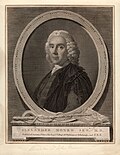





- January 1 – Johann Pfeiffer, German violinist (d. 1761)
- January 7
- Wilhelm August von der Osten, Danish civil servant (d. 1764)
- Robert Wallace, minister of the Church of Scotland, writer on population (d. 1771)
- January 9 – Gabriel Hanger, 1st Baron Coleraine, English politician (d. 1773)
- January 11 – William Capell, 3rd Earl of Essex, English courtier and diplomat (d. 1743)
- January 13 – Paul-François de Galluccio, marquis de L'Hôpital, French nobleman and ambassador to Russia (d. 1767)
- January 16 – Jules, Prince of Soubise, French nobleman and Prince of Soubise (d. 1724)
- January 17 – Franz Neumayr, German Jesuit preacher (d. 1765)
- January 19 – Thérèse de Couagne, capitalist and slave owner who played an active role in the economy of New France (d. 1764)
- January 22 – Antoine-Martin Chaumont de La Galaizière, French nobleman (d. 1783)
- January 23 – Joseph François Dupleix, Governor-General of French India and rival of Robert Clive (d. 1763)
- January 26 – Sir Hugh Acland, 6th Baronet, British landowner, politician and MP (d. 1728)
- January 30 – Johann Joachim Quantz, German flautist and composer (d. 1773)
- February 1 – Josse Boutmy, composer, organist and harpsichordist of the Austrian Netherlands (d. 1779)
- February 4 – James Franklin, American colonial author (d. 1735)
- February 5 – William Smellie, Scottish obstetrician and medical instructor (d. 1763)
- February 9 – Sir James Johnstone, 3rd Baronet, Scottish baronet and politician (d. 1772)
- February 13 – Knud Leem, Norwegian priest and linguist (d. 1774)
- February 15 – Vito Maria Amico, Italian monk (d. 1752)
- February 24 – Bernhard Siegfried Albinus, German anatomist (d. 1770)
- February 26
- Giuseppe Pedretti, Italian painter (d. 1778)
- Edward Thompson, prominent Yorkshire politician (d. 1742)
- February 28
- Caio Domenico Gallo, Italian historian (d. 1780)
- Agustín de Montiano y Luyando, Spanish dramatist whose work is linked to Neoclassicism (d. 1764)
- March 6 – Jacques Deschamps, French theologian and priest (d. 1759)
- March 9 – Friederike Caroline Neuber, German actress and theatre director (d. 1760)
- March 12 – Joseph Leblanc dit Le Maigre, Acadian farmer and trader (d. 1772)
- March 20 – József Dravecz, Slovene Roman Catholic priest (d. 1779)
- March 21 – Christian Gottlieb Priber, German immigrant with legal training who emigrated to the British Colonies of North America (d. 1744)
- March 24
- Louis Constantin de Rohan, French prelate of the House of Rohan (d. 1779)
- Yunli, Manchu prince of the Qing dynasty (d. 1738)
- March 30
- Faustina Bordoni, Italian mezzo-soprano (d. 1781)
- Jan Baptist Xavery, Flemish sculptor principally active in the Dutch Republic (d. 1742)
- April 2
- Gaetano Casanova, Italian actor and ballet dancer (d. 1733)
- Sauveur François Morand, French surgeon (d. 1773)
- April 12 – Anton Pichler, Tyrolean goldsmith and artist of engraved gems (d. 1779)
- April 16 – Johann Gottlieb Görner, German composer and organist (d. 1778)
- April 23 – George Anson, 1st Baron Anson, British admiral (d. 1762)
- April 26 – Adam Falckenhagen, German lutenist and composer (d. 1754)
- May 2 – Michael Fabritius, Danish merchant (d. 1746)
- May 5 – Henricus Boelen, American silversmith in New York City (d. 1755)
- May 10 – Jean-Marie Leclair, French violinist (d. 1764)
- May 15 – Countess Palatine Ernestine of Sulzbach, wife of Landgrave William II (d. 1775)
- May 16 – John Berkeley, 5th Baron Berkeley of Stratton, British politician (d. 1773)
- May 20 – Francesco Scipione Maria Borghese, Italian cardinal from the Borghese family (d. 1759)
- May 28 – Frederick Bernard, Count Palatine of Gelnhausen (d. 1739)
- June 2 – Thomas Whincop, English compiler of theatrical history (d. 1730)
- June 4 – Jacob Emden, German rabbi and talmudist who championed Orthodox Judaism (d. 1776)
- June 9 – Augustus Louis, Prince of Anhalt-Köthen, German prince of the House of Ascania (d. 1755)
- June 10 – Johann Caspar Barthel, German canon lawyer (d. 1771)
- June 11 – Francesco Antonio Vallotti, Italian composer (d. 1780)
- June 24 – Heinrich Joseph Johann of Auersperg, fourth Prince of Auersperg (d. 1783)
- July 27 – Isaac Maddox, Anglican clergyman (d. 1759)
- July 31 – Pietro Paolo Vasta, Italian painter (d. 1760)
- August 4 – Susanna Wright, colonial English American poet (d. 1784)
- August 6
- Nicola Salvi, Italian architect (d. 1751)
- Charles VII, Holy Roman Emperor from 1742 to 1745 (d. 1745)
- August 10 – Alexander Kurakin, statesman and diplomat (d. 1749)
- August 17 – Alexander Brodie, Scottish politician (d. 1754)
- August 18 – Princess Benedetta d'Este, noblewoman and princess of the Duchy of Modena and Reggio (d. 1777)
- August 19 – Richard Wingfield, 1st Viscount Powerscourt, Irish politician and peer (d. 1751)
- August 26 – Giovanni Battista Tagliasacchi, Italian painter of the late-Baroque period (d. 1737)
- August 28 – Armande de La Tour d'Auvergne, French noblewoman and Princess of Epinoy by marriage (d. 1717)
- August 30 – Henry Flitcroft, major English architect in the second generation of Palladianism (d. 1769)
- September 2 – Thomas Deacon, English non-juror bishop (d. 1753)
- September 6 – James Foster, English Baptist minister (d. 1753)
- September 16 – St George Caulfeild, Lord Chief Justice of Ireland (d. 1778)
- September 17 – John Gardner, American judge (d. 1764)
- September 18 – Cornelius Heinrich Dretzel, German organist and composer (bapt. 1697–1775) (d. 1775)
- September 19 – Alexander Monro, Scottish surgeon and anatomist (d. 1767)
- September 25 – Francis Josias, Duke of Saxe-Coburg-Saalfeld (d. 1764)
- September 27 – Franz Ernst Brückmann, German mineralogist born at Mariental (d. 1753)
- October 6 – Sir Robert Austen, 4th Baronet, British politician (d. 1743)
- October 8
- Augustine Françoise de Choiseul, French aristocrat (d. 1728)
- William Smith, American lawyer and jurist (d. 1769)
- October 9 – Pierre Philibert de Blancheton, French politician and music patron and collector (d. 1756)
- October 15 – Leopold Innocenty Nepomucen Polzer, Polish lawyer (d. 1753)
- October 16
- Nicholas Amhurst, English poet and political writer (d. 1742)
- Marie Anne de Bourbon, Superintendent of the Household to the French queen Marie Leszczyńska (d. 1741)
- October 18
- Canaletto, Italian painter from the Republic of Venice (d. 1768)
- Luigi Maria Torregiani, Italian Cardinal (d. 1777)
- October 19 – Claude-Pierre Goujet, French abbé and littérateur (d. 1767)
- October 22 – Mary Seymour, Duchess of Somerset (d. 1768)
- October 25 – Bartolomeo Ruspoli, Cardinal of the Roman Catholic Church (d. 1741)
- October 26 – John Peter Zenger, German printer and journalist in New York City (d. 1746)
- October 28 – Johann Gottfried Auerbach, Austrian painter and etcher (d. 1753)
- October 29 – Georg Desmarées, Swedish-born German portrait painter (d. 1776)
- October 31 – Johann Christian Fiedler, German portrait painter (d. 1765)
- November 2 – James Douglas, 3rd Marquess of Queensberry, Scottish noble (d. 1715)
- November 6 – Euseby Isham, English academic administrator at the University of Oxford (d. 1755)
- November 8 – Giovanni Lami, Italian jurist (d. 1770)
- November 9 – August Aleksander Czartoryski, member of the Polish nobility (Lang-pl (d. 1782)
- November 10
- Louise Hippolyte, Princess of Monaco (d. 1731)
- William Hogarth, English artist (d. 1764)
- November 13 – Lord William Manners, English nobleman, Whig politician and MP (d. 1772)
- November 15 – Johann Baring, German merchant (d. 1748)
- November 17 – René-Prosper Tassin, French historian (d. 1777)
- November 21 – Mateša Antun Kuhačević, Croatian poet and politician from Senj (d. 1772)
- November 23 – John Gill, English Baptist pastor (d. 1771)
- November 25
- Maria Karolina Sobieska (d. 1740)
- Gerhard Tersteegen, German Reformed religious writer and hymnist (d. 1769)
- November 30 – Johann Albrecht Korff, Russian diplomat (d. 1766)
- December 4 – Nicolas-Charles-Joseph Trublet, French churchman (canon of Saint-Malo) and moralist (d. 1770)
- December 6 – Carlo Arrigoni, Italian composer and musician active in several countries (d. 1744)
- December 7 – Peter August, Duke of Schleswig-Holstein-Sonderburg-Beck (d. 1775)
- December 11
- Sakaki Hyakusen, Japanese painter in the nanga style (d. 1752)
- Pyotr Saltykov (d. 1772)
- December 14 – Soloman Sprecher von Bernegg, Austrian military commander (d. 1758)
- December 18 – Marcantonio Dal Re, Italian engraver and publisher (d. 1766)
- December 21
- Charles Bennet, 2nd Earl of Tankerville, British peer and politician (d. 1753)
- Georg Erhard Hamberger, German professor of medicine (d. 1755)
- December 27 – Sollom Emlyn, Irish legal writer (d. 1754)
1698











- January 1 – Leonardo VII Tocco, Italian noble, the Prince of Montemiletto and the titular Prince of Achaea (d. 1776)
- January 3 – Metastasio, (b. Pietro Antonio Domenico Trapassi), Italian poet and opera librettist (d. 1782)
- January 7 – Thomas Southwell, 2nd Baron Southwell, Irish peer, politician and freemason (d. 1766)
- January 21 – Auguste Louise of Württemberg-Oels, Duchess of Württemberg-Oels by birth and by marriage Duchess of Saxe-Weissenfels-Barby (d. 1739)
- February 4 – Heinrich August de la Motte Fouqué, Prussian Lieutenant general and General der Infanterie and a confidant of King Frederick the Great (d. 1774)
- February 5 – Germain-François Poullain de Saint-Foix, 18th-century French writer and playwright (d. 1776)
- February 7 – Nicolas Sarrabat, French mathematician and scientist (d. 1739)
- February 16
- Pierre Bouguer, French mathematician, geophysicist, geodesist, and astronomer (d. 1758)
- Johann Elias Ridinger, German painter (d. 1767)
- February 19 – William FitzRoy, 3rd Duke of Cleveland, English nobleman (d. 1774)
- February 20
- Gerard Arnout Hasselaer, burgomaster and counsellor of the city of Amsterdam (d. 1766)
- Bernardo Tanucci, Italian statesman (d. 1783)
- February 22 – Giovanni Battista de' Rossi, Italian Roman Catholic priest (d. 1764)
- February 23 – Thomas Bladen, colonial governor in North America and British MP (d. 1780)
- February 28 – Sigismund von Schrattenbach, Prince-Archbishop of Salzburg (d. 1771)
- March 6 – Johannes Alberti, Dutch theologian (d. 1762)
- March 17 – Lady Jane Douglas, Scottish noblewoman (d. 1753)
- March 26 – Václav Prokop Diviš, Czech priest, scientist and inventor (d. 1765)
- April 1 – Steven Hoogendijk, Rotterdam watch and instrument maker and physicist (d. 1788)
- April 2 – Henry Edgar, Scottish Episcopal minister, Bishop of Fife from 1762 to 1765 (d. 1765)
- April 5 – Anne Hamilton, 2nd Countess of Ruglen, Scottish noblewoman (d. 1748)
- April 19 – Daniel Gerdes, German Calvinist theologian and historian (d. 1765)
- April 28 – John Phillipson, British Navy administrator, commissioner, MP for over 20 years (d. 1756)
- May 1 – Francesco Robba, Italian sculptor (d. 1757)
- May 8 – Henry Baker, British naturalist (d. 1774)
- May 10
- Cuthbert Ellison, British Army officer and MP for Shaftesbury (d. 1785)
- François Parfaict, 18th-century French theatre historian (d. 1753)
- May 11 – Pierre Contant d'Ivry, French architect and designer (d. 1777)
- May 17
- Gio Nicola Buhagiar, Maltese painter (d. 1752)
- Sir John Major, 1st Baronet, British merchant (d. 1781)
- May 22 – Lord William Beauclerk, British army officer and politician (d. 1733)
- May 24 – John, Count Palatine of Gelnhausen (d. 1780)
- June 2 – Henry Miles, English Dissenting minister, scientific writer, Fellow of the Royal Society (d. 1763)
- June 15 – George Browne, Irish soldier of fortune in Russian service (d. 1792)
- June 19
- Aoki Konyō, Confucian scholar (d. 1769)
- Weliwita Sri Saranankara Thero, Last Sangharaja of Sri Lanka (d. 1778)
- June 22 – Charles-Hugues Le Febvre de Saint-Marc, 18th-century French playwright and homme de lettres (d. 1769)
- June 23 – Lord Nassau Powlett, English army officer and MP (d. 1741)
- July 8 – Nicolò Maria Antonelli, Italian Cardinal in the Roman Catholic Church (d. 1767)
- July 11
- Jean-Michel Chevotet, French architect (d. 1772)
- George Turnbull, Scottish philosopher (d. 1748)
- July 17 – Pierre Louis Moreau de Maupertuis, French mathematician (d. 1759)
- July 19
- Johann Jakob Bodmer, Swiss author (d. 1783)
- John Clavering, English MP and Groom of the Bedchamber at the Court of George II (d. 1762)
- July 24 – František Jiránek, Czech (Bohemian) Baroque composer (d. 1778)
- August 18 – Samuel Klingenstierna, Swedish mathematician and scientist (d. 1765)
- August 20 – Louis Fornel, Canadian merchant (d. 1745)
- August 24 – Erik Pontoppidan, Danish author (d. 1764)
- August 29
- Richard Pearsall, English Congregationalist minister, friend of Philip Doddridge (d. 1762)
- Jacob Vernet, prominent theologian in Geneva (d. 1789)
- September 6 – Jean Thurel, French soldier (d. 1807)
- September 8
- François Francoeur, French composer and violinist (d. 1787)
- Friederike Charlotte of Hesse-Darmstadt, princess of Hesse-Darmstadt and through her marriage a princess of Hesse-Kassel (d. 1777)
- September 14 – Charles François de Cisternay du Fay, French chemist and superintendent of the Jardin du Roi (d. 1739)
- September 15 – Pier Francesco Guala, Italian painter (d. 1757)
- September 23 – Lewis Morris, colonial American judge (d. 1762)
- September 26 – William Cavendish, 3rd Duke of Devonshire, British nobleman, Whig politician and MP (d. 1755)
- September 28 – Joachim Christian von Tresckow, Prussian Lieutenant General (d. 1762)
- October 6 – François-Bernard Lépicié, 18th-century French engraver (d. 1755)
- October 7 – Henry Madin, French composer at the Chapelle royale (d. 1748)
- October 12 – Jean Paul Timoléon de Cossé-Brissac, Marshal of France (d. 1784)
- October 13 – Giacomo Ceruti, Italian late Baroque painter (d. 1767)
- October 23
- Ange-Jacques Gabriel, principal architect of King Louis XV of France (d. 1782)
- John Jortin, English church historian (d. 1770)
- October 30
- Peter Thompson, English merchant (d. 1770)
- Paul Troger, Austrian painter (d. 1762)
- November 4 – Caleb Fleming, English dissenting minister and Polemicist (d. 1779)
- November 6 – Sir Alexander Lauder, 4th Baronet (d. 1730)
- November 8 – Alberico Archinto, Italian cardinal and papal diplomat (d. 1758)
- November 10 – Maria Taylor Byrd, colonial woman who managed her and her husband William Byrd II's Westover Plantation when he was absent (d. 1771)
- November 22 – Pierre de Rigaud, marquis de Vaudreuil-Cavagnial, Canadian-born colonial governor of French Canada in North America (d. 1778)
- November 23 – Jacob Johann Köhler, Estonian printer who published the first Estonian-language Bible in 1739 (d. 1757)
- November 24 – Charles Douglas, 3rd Duke of Queensberry, Scottish nobleman, extensive landowner, Privy Counsellor, Vice Admiral of Scotland (d. 1778)
- November 28 – Charlotta Frölich, Swedish agronomist (d. 1770)
- December 2 – Oliver Legipont, German Benedictine bibliographer (d. 1758)
- December 6 – Anthony Mooyart, acting Governor of Ceylon during the Dutch period in Ceylon (d. 1767)
- December 9 – Mark Hiddesley, Anglican churchman (d. 1773)
- December 20 – Paul Fourdrinier, English engraver (d. 1758)
- December 21 – Philip Wharton, 1st Duke of Wharton, powerful Jacobite politician (d. 1731)
- December 24 – William Warburton, English critic and Bishop of Gloucester (d. 1779)
- December 25 – Jacobus Houbraken, Dutch engraver and the son of the artist and biographer Arnold Houbraken (d. 1780)
- December 26 – Filippo della Valle, Italian late-Baroque or early Neoclassic sculptor (d. 1768)
- December 27 – Vlaho Kabužić, Ragusan nobleman and diplomat (d. 1750)
- date unknown
- Bernard Forest de Bélidor, French engineer (d. 1761)
- William Moraley, English-American indentured servant and autobiographer, a primary source for life in the Province of Pennsylvania (d. 1762)
- Baal Shem Tov, Polish rabbi and founder of the Hasidic movement of Judaism.
1699











- January 2 – FitzRoy Henry Lee, British officer of the Royal Navy, Commodore Governor of the Colony of Newfoundland (d. 1750)
- January 9
- Christian Tobias Damm, renowned German Classical philologist (d. 1778)
- Robert Joseph Pothier, French jurist (d. 1772)
- January 11 – Friedrich Wilhelm Quirin von Forcade de Biaix, Royal Prussian Lieutenant General (d. 1765)
- January 14 – Jakob Adlung, German organist, teacher, instrument maker, music historian, composer and music theorist (d. 1762)
- January 16 – Franz Christoph Anton, Count of Hohenzollern-Sigmaringen, member of the House of Hohenzollern (d. 1767)
- January 20 – Thomas Hervey, politician (d. 1775)
- January 30 – Infanta Francisca Josefa of Portugal, Portuguese princess, the last of eight children of King Peter II of Portugal (d. 1736)
- January 31 – Mathias Haydn, father of two famous composers (d. 1763)
- February 2 – Hugh MacDonald, Roman Catholic bishop, Vicar Apostolic of the Highland District of Scotland 1731–1773 (d. 1773)
- February 9 – Étienne Jeaurat, French painter (d. 1789)
- February 10 – George Bowman, 18th-century American pioneer (d. 1768)
- February 11
- Bertrand-François Mahé de La Bourdonnais, French naval officer and colonial administrator (d. 1753)
- Samuel Heathcote, British politician who sat in the House of Commons from 1740 to 1747 (d. 1775)
- February 14 – Odet-Joseph Giry, French clergyman (d. 1761)
- February 15 – Giovanni Maria Morlaiter, Italian sculptor of the Rococo or late-Baroque (d. 1782)
- February 17 – Georg Wenzeslaus von Knobelsdorff, painter and architect in Prussia (d. 1753)
- February 24 – Giuseppe Pascaletti, Italian painter (d. 1757)
- March 3 – Georg Detlev von Flemming, General in Polish-Saxon service (d. 1771)
- March 7 – António Nunes Ribeiro Sanches, 18th-century Portuguese physician (d. 1783)
- March 8 – Johan Friederich Wewer, Danish merchant and ship-owner (d. 1759)
- March 13 – Jacob Faggot, Swedish scientist, civil servant and surveyor (d. 1777)
- March 17
- Radu Cantacuzino, 18th-century Romanian prince (d. 1761)
- Charles O'Brien, 6th Viscount Clare, Irish military officer in French service (d. 1761)
- March 23 – John Bartram, American botanist (d. 1777)
- March 24
- David Renaud Boullier, Dutch Huguenot theologian (d. 1759)
- Paul Gottlieb Werlhof, German physician and poet who was a native of Helmstedt (d. 1767)
- March 25
- James Calthorpe, Yeoman of the Removing Wardrobe (d. 1784)
- Johann Adolph Hasse, German composer (d. 1783)
- March 26 – Hubert-François Gravelot, French engraver (d. 1773)
- March 30 – Edward Stradling, Welsh politician (d. 1726)
- March 31 – Françoise-Louise de Warens, benefactress and mistress of Jean-Jacques Rousseau (d. 1762)
- April 3 – Jean-Baptiste Forqueray, player of the viol and a composer (d. 1782)
- April 10 – Catharina Sperling-Heckel, German miniature painter (d. 1741)
- April 13 – Alexander Ross, Scottish poet (d. 1784)
- April 14 – Frederick III, Duke of Saxe-Gotha-Altenburg (d. 1772)
- April 17 – Robert Blair, Scottish poet and cleric (d. 1746)
- April 19 – Valentin Metzinger, French-born Austrian-Slovenian painter (d. 1759)
- April 20 – Sir Thomas Lowther, 2nd Baronet, English landowner (d. 1745)
- April 25 – Johann Gottlieb Siegel, German legal scholar (d. 1755)
- April 27
- Thomas Belasyse, 1st Earl Fauconberg, British peer (d. 1774)
- Jacopo Stellini, Italian abbot (d. 1770)
- Albert Wolfgang, Count of Schaumburg-Lippe, ruler of the County of Schaumburg-Lippe (d. 1748)
- April 28 – Joseph Spence, historian (d. 1768)
- May 2 – Daniel Betts Jr., member of the Connecticut House of Representatives from Norwalk (d. 1783)
- May 13 – Marquis of Pombal, Prime Minister of Portugal (d. 1782)
- May 14
- Ryk Tulbagh, Governor of the Dutch Cape Colony (d. 1771)
- Hans Joachim von Zieten, Prussian field marshal (d. 1786)
- May 15 – Sampson Lloyd, English iron manufacturer and banker, who co-founded Lloyds Bank (d. 1779)
- May 23 – William Parks, 18th-century printer and journalist in England and Colonial America (d. 1750)
- May 24 – Adam Ignacy Komorowski, Polish Roman Catholic archbishop (d. 1759)
- May 25
- Pattee Byng, 2nd Viscount Torrington, British Army officer and politician (d. 1747)
- Anna Leszczyńska, eldest child of Stanisław Leszczyński and Catherine Opalińska (d. 1717)
- May 26 – Nikita Trubetskoy, Russian statesman, Field Marshal, minister of defense of Russia (d. 1767)
- May 28 – Laurent Cars, French designer and engraver (d. 1771)
- May 29 – Pierre Rémond de Sainte-Albine, 18th-century French historian and playwright (d. 1778)
- May 31 – Alexander Cruden, Scottish author of an early concordance to the Bible (d. 1770)
- June 4 – William Moore, Banbury MP (d. 1746)
- June 6
- Johann Georg Estor, German theorist of public law (d. 1773)
- Alamgir II, the fifteenth Mughal Emperor of India (d. 1759)
- June 17 – François-Alexandre Aubert de La Chesnaye Des Bois, French writer, genealogist and compiler (d. 1784)
- June 20 – William Gustav of Anhalt-Dessau, German prince of the House of Ascania, heir to the principality of Anhalt-Dessau (d. 1737)
- June 26 – Marie Thérèse Rodet Geoffrin, French salon holder (d. 1777)
- July 14
- Vere Beauclerk, 1st Baron Vere, Royal Navy officer, British peer and MP (d. 1781)
- Philipp Ludwig von Sinzendorf, Austrian cardinal of the Catholic Church (d. 1747)
- July 15
- Richard Crowle, Yorkshire lawyer and a Member of Parliament for Kingston upon Hull (d. 1757)
- Henrietta Knight, Lady Luxborough, English poet and letter writer, now mainly remembered as a gardener (d. 1756)
- July 18 – Barthélemy Hus-Desforges, 18th-century French comedian and troupe leader (d. 1786)
- July 21 – Heinrich XXIX, Count of Reuss-Ebersdorf, member of the House of Reuss Younger Line, Count Ebersdorf from 1711 until his death (d. 1747)
- July 25 – Charles Beckingham, English poet and dramatist (d. 1731)
- July 28
- John Coutts, British merchant and banker who became Lord Provost of Edinburgh in 1742 (d. 1750)
- Princess Amalia d'Este (d. 1778)
- August 5 – Ferdinand Maria Innocenz of Bavaria, Bavarian prince and an Imperial Field marshal (d. 1738)
- August 10 – Christoph Gottlieb Schröter, German composer and organist (d. 1782)
- August 25 – Charles Étienne Louis Camus, French mathematician and mechanician born at Crécy-en-Brie (d. 1768)
- August 29 – Mastani, daughter of Chhatrasal and Ruhani Bai Begum (d. 1740)
- August 30 – James Wemyss, 5th Earl of Wemyss, son of David Wemyss (d. 1756)
- September 1 – George Benson, English Presbyterian pastor and theologian (d. 1762)
- September 2 – Elizabeth Younger, actress and dancer (d. 1762)
- September 11 – Anna Maria of Liechtenstein, princess consort of Liechtenstein (d. 1753)
- September 12 – John Martyn, English botanist (d. 1768)
- September 28 – Johann Friedrich Ruhe, German composer (d. 1776)
- September 29 – Charles Calvert, 5th Baron Baltimore, British nobleman and Proprietary Governor of the Province of Maryland (d. 1751)
- October 2 – Ferdinande Henriette, Countess of Stolberg-Gedern (d. 1750)
- October 4 – Vieira Lusitano, Portuguese court painter (d. 1783)
- October 10 – William Prentis, merchant in Williamsburg, Virginia (d. 1765)
- October 13 – Jeanne Quinault, French actress and playwright (d. 1783)
- October 21 – Hans Christoph Friedrich Graf von Hacke, Prussian General and Commandant of Berlin (d. 1754)
- October 23 – John Verney, British barrister, judge, Tory and then Whig politician and MP (d. 1741)
- October 27 – Thomas Fonnereau, British merchant and politician (d. 1779)
- November 2 – Jean-Baptiste-Siméon Chardin, French painter (d. 1779)
- November 5 – Merrik Burrell, British politician (d. 1787)
- November 8 – Sir Erasmus Philipps, 5th Baronet (d. 1743)
- November 9 – Sir Robert Kemp, 4th Baronet, British landowner, Tory politician and MP (d. 1752)
- November 11
- Ferdinando Fuga, Italian architect (d. 1782)
- Sulaiman Badrul Alam Shah of Johor, 12th Sultan and Yang di-Pertuan Besar of Johor and Pahang and their dependencies who reigned from 1722 to 1760 (d. 1760)
- Natalia Lopukhina, Russian noble (d. 1763)
- November 18 – Gerrit Braamcamp, successful Roman Catholic distiller (d. 1771)
- November 20 – Antun Kanižlić, Croatian Jesuit and poet (d. 1777)
- November 22 – François de Chennevières, French poet and librettist (d. 1779)
- November 25 – Pierre Subleyras, French painter (d. 1749)
- November 30 – King Christian VI of Denmark (d. 1746)
- December 2 – John White, English politician who sat in the House of Commons (d. 1769)
- December 11 – Sarah Chapone, English legal theorist, pamphleteer, and prolific letter writer (d. 1764)
- December 17 – Charles-Louis Mion, French composer (d. 1775)
- December 19 – William Bowyer, English printer (d. 1777)
- December 29 – Friedrich Ludwig Abresch, Dutch philologist of German origins (d. 1782)








































